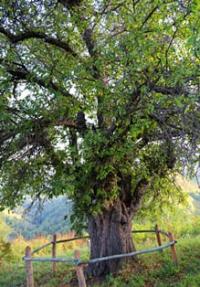You are here
Sievers apple tree is a long-liver in Dzungarian Alatau.

Sievers apple tree in Kazakhstan.
"...The goddess flora delighted me with a forest of the most beautiful dwarf apple trees, which here, near Urjar, grow wild on both banks. I forgot fatigue, heat, rockfall and everything else and drove into the apple trees like a goblin and began to feed. Forgive me for this playfulness, you know, I was born in the land of apples... In Kyrgyz they are called alma."
Johann Sievers. "Letters from Siberia". 1793.
"A completely new phenomenon for us were wild apple trees covered with luxurious pinkish-red flowers. They testified that we were in a moderate climate, south of 46 degrees latitude. These wild apple trees (Pyrus Sieverianus) bear small but edible fruits, quite pleasant sweet and sour taste, which ripen around the middle of July and are considered a delicacy by the Kirghiz. To reduce the labor of picking the fruit, the natives, unfortunately, often prefer to cut down the entire tree. According to A. Shrenk, wild apple trees grow in the northernmost foothills of Ala-Tau, along the steppe hills of Tekeli, and according to Semenov, they are found even further north, in one gorge of Tarbagatai, but only in this one. Meyer's testimony that they grow along with wild cherries along the banks of Balkhash is most likely erroneous."
"Journey to Western Siberia by Dr. O. Finsch and A. Brehm." 1882.
Sivers apple trees in Zhongar-Alatau park.
Long-living Sivers apple tree is located at an altitude of 1458 meters above sea level, located in area between Lepsy and Chernaya Rechka rivers, 1 kilometer (along trail) to south and slightly east of apiary of Rodmir Vishnyakov, 6 kilometers southeast of Chernaya Rechka cordon, 14.5 kilometers southeast of village of Lepsinsk on territory of Lepsinsky branch of Zhongar-Alatau Natural Park in Alakol district of Zhetysu region.
Sievers apple tree (Malus sieversii) is a wild fruit species of foothill apple trees from Central Asia and Kazakhstan. The first description of this type of apple tree (1793) belongs to the botanist Johann Sievers, after whom the plant was named.
According to DNA studies, it has been proven that the Sievers apple tree is the ancestor of most cultivated varieties of apple trees. This tree grows in a limited area (from Tarbagatai to the Western Tien Shan), forming forests and inhabiting slopes and river valleys at an altitude of 1500 to 2000 meters above sea level.
Life expectancy is up to 150 years, and begins to bear fruit at the age of 12 in nature. In cultivation it bears fruit in 4 - 5 years. The long-living Sievers apple tree is the only one growing in the region on the northern slope of the Dzungarian Alatau ridge, between the Vankova Griva ridge in the west and the Zhunzhuru mountains in the east.
The apple tree reaches a height of 18 meters, the trunk diameter at the base is 1.8 meters, and the crown diameter is 15 meters. Using a special technique developed by specialists from the Lepsinsky branch of the Zhongar-Alatau Park, the age of the Sivers apple tree was determined (as an exception); it was 180 years.
The tree has a passport and is specially registered in the park. A path was laid from the apiary of “Rodmir Vishnyakov” to the tree, and a gazebo was built next to the tree on the western side. From the apple tree to the southeast there is a panorama of the Lepsy River valley, Mount Zhamantas 2133 meters above sea level, and Mount Zhunzhuru 1733 meters above sea level rises in the east.
The path from the apiary passes through a forest in which Sivers apple trees and aspen trees mainly grow. Along the trail there are black currant bushes, raspberry and blackberry thickets. This is the favorite habitat of the Tien-Shan brown bear (Ursus arctos isabellinus), it is a separate subspecies of the brown bear (Ursus arctos).
The Tien-Shan brown bear is omnivorous: it feeds on herbs, rhizomes, bulbs, fruits and berries. Sometimes it catches marmots and pikas. He will not refuse carrion either. The bear alternates eating the fruits of the Sievers apple tree, black currants and blackberries.
The Central Asian wild boar (S.s. nighpes (Blanford, 1875), which rises in the summer to alpine meadows. The wild boar is active at dusk and at night. It lives in groups of 6 - 16 individuals, with the exception of adult males and females with underyearlings.
The wild boar usually has permanent habitats throughout the year, their size depends on the productivity of the land. The size of the habitats of single males reaches 10 square kilometers in summer. The badger (Meles meles) also shares the territory with other animals.
Geographic coordinates of long-lived Sievers apple tree: N45°30'24 E80°45'06

Authority and photos by:
Alexander Petrov.







